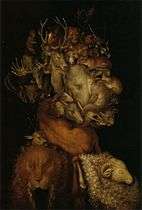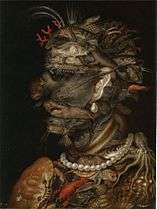Classical element
Classical elements typically refer to the concepts of earth, water, air, fire, and (later) aether, which were proposed to explain the nature and complexity of all matter in terms of simpler substances.[1][2] Ancient cultures in Greece, Persia, Babylonia, Japan, Tibet, and India had all similar lists, sometimes referring in local languages to "air" as "wind" and the fifth element as "void". The Chinese Wu Xing system lists Wood (木 mù), Fire (火 huǒ), Earth (土 tǔ), Metal (金 jīn), and Water (水 shuǐ), though these are described more as energies or transitions rather than as types of material.
| Classical elements |
|---|
|
Stoicheion (στοιχεῖον) |
|
Wuxing (五行) |
|
Godai (五大) |
|
Bön |
|
Alchemy |
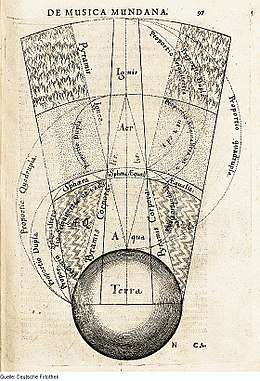
These different cultures and even individual philosophers had widely varying explanations concerning their attributes and how they related to observable phenomena as well as cosmology. Sometimes these theories overlapped with mythology and were personified in deities. Some of these interpretations included atomism (the idea of very small, indivisible portions of matter), but other interpretations considered the elements to be divisible into infinitely small pieces without changing their nature.
While the classification of the material world in ancient Indian, Hellenistic Egypt, and ancient Greece into Air, Earth, Fire and Water was more philosophical, during the Islamic Golden Age medieval middle eastern scientists used practical, experimental observation to classify materials.[3] In Europe, the Ancient Greek system of Aristotle evolved slightly into the medieval system, which for the first time in Europe became subject to experimental verification in the 1600s, during the Scientific Revolution.
Modern science does not support the classical elements as the material basis of the physical world. Atomic theory classifies atoms into more than a hundred chemical elements such as oxygen, iron, and mercury. These elements form chemical compounds and mixtures, and under different temperatures and pressures, these substances can adopt different states of matter. The most commonly observed states of solid, liquid, gas, and plasma share many attributes with the classical elements of earth, water, air, and fire, respectively, but these states are due to similar behavior of different types of atoms at similar energy levels, and not due to containing a certain type of atom or a certain type of substance.
Ancient history
Ancient Greece
In Western thought, the four elements earth, water, air, and fire as proposed by Empedocles (5th century BC) frequently occur.[4] In ancient Greece, discussion of the elements in the context of searching for an arche ("first principle") predated Empedocles by several centuries. For instance, Thales suggested in the 7th century BCE that water was the ultimate underlying substance from which everything is derived; Anaximenes subsequently made a similar claim about air. However, none before Empedocles proposed that matter could ultimately be composed of all four elements in different combinations of one another.[4] Later on, Aristotle added a fifth element to the system, which he called aether.
Persia
The Persian philosopher Zarathustra (600-583 BCE), also known as Zoroaster, described the four elements of earth, water, air and fire as “sacred,” i.e., “essential for the survival of all living beings and therefore should be venerated and kept free from any contamination”.[5]
Cosmic elements in Babylonia
In Babylonian mythology, the cosmogony called Enûma Eliš, a text written between the 18th and 16th centuries BC, involves four gods that we might see as personified cosmic elements: sea, earth, sky, wind. In other Babylonian texts these phenomena are considered independent of their association with deities,[6] though they are not treated as the component elements of the universe, as later in Empedocles.
India
The concept of the five elements formed a basis of analysis in both Hinduism and Buddhism. In Hinduism, particularly in an esoteric context, the four states-of-matter describe matter, and a fifth element describes that which was beyond the material world. This fifth element has been called akasha in India and quintessence in Europe. Similar lists existed in ancient China, Korea and Japan. In Buddhism the four great elements, to which two others are sometimes added, are not viewed as substances, but as categories of sensory experience.
Hinduism
The system of five elements are found in Vedas, especially Ayurveda, the pancha mahabhuta, or “five great elements”, of Hinduism are bhūmi (earth),[7] ap or jala (water), tejas or agni (fire), marut, vayu or pavan (air or wind) and vyom or shunya (space or zero) or akash (aether or void).[8] They further suggest that all of creation, including the human body, is made up of these five essential elements and that upon death, the human body dissolves into these five elements of nature, thereby balancing the cycle of nature.[9]
The five elements are associated with the five senses, and act as the gross medium for the experience of sensations. The basest element, earth, created using all the other elements, can be perceived by all five senses — (i) hearing, (ii) touch, (iii) sight, (iv) taste, and (v) smell. The next higher element, water, has no odor but can be heard, felt, seen and tasted. Next comes fire, which can be heard, felt and seen. Air can be heard and felt. “Akasha” (aether) is beyond the senses of smell, taste, sight, and touch; it being accessible to the sense of hearing alone.[10][11][12]
Buddhism
In the Pali literature, the mahabhuta (“great elements”) or catudhatu (“four elements”) are earth, water, fire and air. In early Buddhism, the four elements are a basis for understanding suffering and for liberating oneself from suffering. The earliest Buddhist texts explain that the four primary material elements are the sensory qualities solidity, fluidity, temperature, and mobility; their characterization as earth, water, fire, and air, respectively, is declared an abstraction — instead of concentrating on the fact of material existence, one observes how a physical thing is sensed, felt, perceived.[13]
The Buddha’s teaching regarding the four elements is to be understood as the base of all observation of real sensations rather than as a philosophy. The four properties are cohesion (water), solidity or inertia (earth), expansion or vibration (air) and heat or energy content (fire). He promulgated a categorization of mind and matter as composed of eight types of “kalapas” of which the four elements are primary and a secondary group of four are color, smell, taste, and nutriment which are derivative from the four primaries.
Thanissaro Bhikkhu (1997) renders an extract of Shakyamuni Buddha’s from Pali into English thus:
Just as a skilled butcher or his apprentice, having killed a cow, would sit at a crossroads cutting it up into pieces, the monk contemplates this very body — however it stands, however it is disposed — in terms of properties: ‘In this body there is the earth property, the liquid property, the fire property, & the wind property.’[14]
Tibetan Buddhist medical literature speaks of the Panch Mahābhūta (five elements).[15]
China
The Chinese had a somewhat different series of elements, namely Fire, Earth, Metal (literally gold), Water and Wood, which were understood as different types of energy in a state of constant interaction and flux with one another, rather than the Western notion of different kinds of material. Historians of science have noted a fundamental difference between Greek element theories and Chinese matter theories.[16]
Although it is usually translated as “element”, the Chinese word xing literally means something like “changing states of being”, “permutations” or “metamorphoses of being”.[17] In fact Sinologists cannot agree on any single translation. The Chinese elements were seen as ever changing and moving – one translation of wu xing is simply “the five changes”.
The Wu Xing are chiefly an ancient mnemonic device for systems with five stages; hence the preferred translation of “movements”, “phases” or “steps” over “elements.”
In the bagua, metal is associated with the divination figure 兌 Duì (☱, the lake or marsh: 澤/泽 zé) and with 乾 Qián (☰, the sky or heavens: 天 tiān). Wood is associated with 巽 Xùn (☴, the wind: 風/风 fēng) and with 震 Zhèn (☳, the arousing/thunder: 雷 léi). In view of the durability of meteoric iron, metal came to be associated with the aether, which is sometimes conflated with Stoic pneuma, as both terms originally referred to air (the former being higher, brighter, more fiery or celestial and the latter being merely warmer, and thus vital or biogenetic). In Taoism, qi functions similarly to pneuma in a prime matter (a basic principle of energetic transformation) that accounts for both biological and inanimate phenomena.
In Chinese philosophy the universe consists of heaven and earth. The five major planets are associated with and even named after the elements: Jupiter 木星 is Wood (木), Mars 火星 is Fire (火), Saturn 土星 is Earth (土), Venus 金星 is Metal (金), and Mercury 水星 is Water (水). Also, the Moon represents Yin (陰), and the Sun 太陽 represents Yang (陽). Yin, Yang, and the five elements are associated with themes in the I Ching, the oldest of Chinese classical texts which describes an ancient system of cosmology and philosophy. The five elements also play an important part in Chinese astrology and the Chinese form of geomancy known as Feng shui.
The doctrine of five phases describes two cycles of balance, a generating or creation (生, shēng) cycle and an overcoming or destruction (克/剋, kè) cycle of interactions between the phases.
Generating
- Wood feeds fire;
- Fire creates earth (ash);
- Earth bears metal;
- Metal collects water;
- Water nourishes wood.
Overcoming
- Wood parts earth;
- Earth absorbs water;
- Water quenches fire;
- Fire melts metal;
- Metal chops wood.
There are also two cycles of imbalance, an overacting cycle (乘,cheng) and an insulting cycle (侮,wu).
Greece
| Aristotelian elements and qualities |
 Four classical elements Empedoclean elements |
The ancient Greek concept of four basic elements, these being earth (γῆ gê), water (ὕδωρ hýdōr), air (ἀήρ aḗr), and fire (πῦρ pŷr), dates from pre-Socratic times and persisted throughout the Middle Ages and into the Renaissance, deeply influencing European thought and culture.
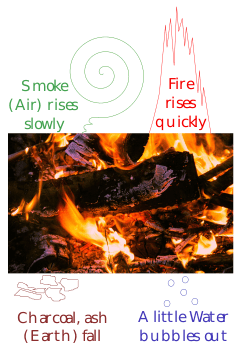
Sicilian philosopher Empedocles (ca. 450 BC) proved (at least to his satisfaction) that air was a separate substance by observing that a bucket inverted in water did not become filled with water, a pocket of air remaining trapped inside.[18] Prior to Empedocles, Greek philosophers had debated which substance was the primordial element from which everything else was made; Heraclitus championed fire, Thales supported water, and Anaximenes plumped for air.[19] Anaximander argued that the primordial substance was not any of the known substances, but could be transformed into them, and they into each other.[20] Empedocles was the first to propose four elements, fire, earth, air, and water.[21] He called them the four “roots” (ῥιζώματα, rhizōmata).
Plato seems to have been the first to use the term “element (στοιχεῖον, stoicheîon)” in reference to air, fire, earth, and water.[22] The ancient Greek word for element, stoicheion (from stoicheo, “to line up”) meant “smallest division (of a sun-dial), a syllable”, as the composing unit of an alphabet it could denote a letter and the smallest unit from which a word is formed.
In On the Heavens, Aristotle defines "element" in general:
An element, we take it, is a body into which other bodies may be analysed, present in them potentially or in actuality (which of these, is still disputable), and not itself divisible into bodies different in form. That, or something like it, is what all men in every case mean by element.[23]
In his On Generation and Corruption,[24][25] Aristotle related each of the four elements to two of the four sensible qualities:
- Fire is both hot and dry.
- Air is both hot and wet (for air is like vapor, ἀτμὶς).
- Water is both cold and wet.
- Earth is both cold and dry.
A classic diagram has one square inscribed in the other, with the corners of one being the classical elements, and the corners of the other being the properties. The opposite corner is the opposite of these properties, “hot – cold” and “dry – wet”.
Aristotle added a fifth element, aether (αἰθήρ aither), as the quintessence, reasoning that whereas fire, earth, air, and water were earthly and corruptible, since no changes had been perceived in the heavenly regions, the stars cannot be made out of any of the four elements but must be made of a different, unchangeable, heavenly substance.[26] It had previously been believed by pre-Socratics such as Empedocles and Anaxagoras that aether, the name applied to the material of heavenly bodies, was a form of fire. Aristotle himself did not use the term aether for the fifth element, and strongly criticised the pre-Socratics for associating the term with fire. He preferred a number of other terms that indicated eternal movement, thus emphasising the evidence for his discovery of a new element.[27] These five elements have been associated since Plato's Timaeus with the five platonic solids.
A text written in Egypt in Hellenistic or Roman times called the Kore Kosmou (“Virgin of the World”) ascribed to Hermes Trismegistus (associated with the Egyptian god Thoth), names the four elements fire, water, air, and earth. As described in this book:
And Isis answer made: Of living things, my son, some are made friends with fire, and some with water, some with air, and some with earth, and some with two or three of these, and some with all. And, on the contrary, again some are made enemies of fire, and some of water, some of earth, and some of air, and some of two of them, and some of three, and some of all. For instance, son, the locust and all flies flee fire; the eagle and the hawk and all high-flying birds flee water; fish, air and earth; the snake avoids the open air. Whereas snakes and all creeping things love earth; all swimming things love water; winged things, air, of which they are the citizens; while those that fly still higher love the fire and have the habitat near it. Not that some of the animals as well do not love fire; for instance salamanders, for they even have their homes in it. It is because one or another of the elements doth form their bodies’ outer envelope. Each soul, accordingly, while it is in its body is weighted and constricted by these four.
According to Galen, these elements were used by Hippocrates in describing the human body with an association with the four humours: yellow bile (fire), black bile (earth), blood (air), and phlegm (water). Medical care was primarily about helping the patient stay in or return to his/her own personal natural balanced state.[28]
The Neoplatonic philosopher Proclus rejected Aristotle's theory relating the elements to the sensible qualities hot, cold, wet, and dry. He maintained that each of the elements has three properties. Fire is sharp, subtle, and mobile while its opposite, earth, is blunt, dense, and immobile; they are joined by the intermediate elements, air and water, in the following fashion:[29]
| Fire | Sharp | Subtle | Mobile |
|---|---|---|---|
| Air | Blunt | Subtle | Mobile |
| Water | Blunt | Dense | Mobile |
| Earth | Blunt | Dense | Immobile |
Tibet
In Bön or ancient Tibetan philosophy, the five elemental processes of earth, water, fire, air and space are the essential materials of all existent phenomena or aggregates. The elemental processes form the basis of the calendar, astrology, medicine, psychology and are the foundation of the spiritual traditions of shamanism, tantra and Dzogchen.
Tenzin Wangyal Rinpoche states that
physical properties are assigned to the elements: earth is solidity; water is cohesion; fire is temperature; air is motion; and space is the spatial dimension that accommodates the other four active elements. In addition, the elements are correlated to different emotions, temperaments, directions, colors, tastes, body types, illnesses, thinking styles, and character. From the five elements arise the five senses and the five fields of sensory experience; the five negative emotions and the five wisdoms; and the five extensions of the body. They are the five primary pranas or vital energies. They are the constituents of every physical, sensual, mental, and spiritual phenomenon.[30]
The names of the elements are analogous to categorised experiential sensations of the natural world. The names are symbolic and key to their inherent qualities and/or modes of action by analogy. In Bön the elemental processes are fundamental metaphors for working with external, internal and secret energetic forces. All five elemental processes in their essential purity are inherent in the mindstream and link the trikaya and are aspects of primordial energy. As Herbert V. Günther states:
Thus, bearing in mind that thought struggles incessantly against the treachery of language and that what we observe and describe is the observer himself, we may nonetheless proceed to investigate the successive phases in our becoming human beings. Throughout these phases, the experience (das Erlebnis) of ourselves as an intensity (imaged and felt as a “god”, lha) setting up its own spatiality (imaged and felt as a “house” khang) is present in various intensities of illumination that occur within ourselves as a “temple.” A corollary of this Erlebnis is its light character manifesting itself in various “frequencies” or colors. This is to say, since we are beings of light we display this light in a multiplicity of nuances.[31]
In the above block quote the trikaya is encoded as: dharmakaya “god”; sambhogakaya “temple” and nirmanakaya “house”.
Post-classical history
Alchemy
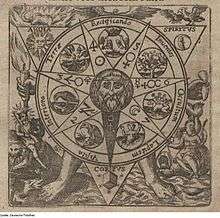
The elemental system used in Medieval alchemy was developed primarily by the Arab alchemist Jābir ibn Hayyān (Geber).[32] His system consisted of the four classical elements of air, earth, fire, and water, in addition to two philosophical elements: sulphur, characterizing the principle of combustibility, "the stone which burns"; and mercury, characterizing the principle of metallic properties. They were seen by early alchemists as idealized expressions of irreducible components of the universe[33] and are of larger consideration within philosophical alchemy.
The three metallic principles—sulphur to flammability or combustion, mercury to volatility and stability, and salt to solidity—became the tria prima of the Swiss alchemist Paracelsus. He reasoned that Aristotle's four element theory appeared in bodies as three principles. Paracelsus saw these principles as fundamental and justified them by recourse to the description of how wood burns in fire. Mercury included the cohesive principle, so that when it left in smoke the wood fell apart. Smoke described the volatility (the mercurial principle), the heat-giving flames described flammability (sulphur), and the remnant ash described solidity (salt).[34]
Islamic
The Islamic philosophers al-Kindi, Avicenna and Fakhr al-Din al-Razi connected the four elements with the four natures heat and cold (the active force), and dryness and moisture (the recipients).[35]
Japan
Japanese traditions use a set of elements called the 五大 (godai, literally "five great"). These five are earth, water, fire, wind/air, and void. These came from Indian Vastu shastra philosophy and Buddhist beliefs; in addition, the classical Chinese elements (五行, wu xing) are also prominent in Japanese culture, especially to the influential Neo-Confucianists during the medieval Edo period.
- Earth represented things that were solid.
- Water represented things that were liquid.
- Fire represented things that destroy.
- Air represented things that moved.
- Void or Sky/Heaven represented things not of our everyday life.
Modern history
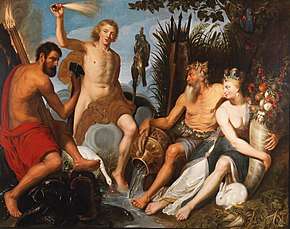
Chemical element
The Aristotelian tradition and medieval alchemy eventually gave rise to modern chemistry, scientific theories and new taxonomies. By the time of Antoine Lavoisier, for example, a list of elements would no longer refer to classical elements.[36] Some modern scientists see a parallel between the classical elements and the four states of matter: solid, liquid, gas and weakly ionized plasma.[37]
Modern science recognizes classes of elementary particles which have no substructure (or rather, particles that are not made of other particles) and composite particles having substructure (particles made of other particles).
Western astrology
Western astrology uses the four classical elements in connection with astrological charts and horoscopes. The twelve signs of the zodiac are divided into the four elements: Fire signs are Aries, Leo and Sagittarius, Earth signs are Taurus, Virgo and Capricorn, Air signs are Gemini, Libra and Aquarius, and Water signs are Cancer, Scorpio, and Pisces.[38]
Criticism
The Dutch historian of science Eduard Jan Dijksterhuis writes that the theory of the classical elements "was bound to exercise a really harmful influence. As is now clear, Aristotle, by adopting this theory as the basis of his interpretation of nature and by never losing faith in it, took a course which promised few opportunities and many dangers for science." [39]
In popular culture
See also
- Alchemy
- Elemental (Renaissance alchemy)
- Five elements (Chinese wǔ xíng)
- Five elements (Hindu mahābhūta) and Four elements (Buddhist mahābhūtāni)
- Five elements (Japanese godai)
- First principle (Pre-Socratic arche and Aristotelian substratum)
- First principle (Chinese qì and Japanese ki)
- First principle (Prima materia in Alchemy)
- Macrocosm and microcosm
- Overview of the fundamental interaction
- Periodic table of the elements (Modern science)
- Philosopher's stone (Middle Ages and Renaissance alchemy)
- Phlogiston theory (History of science)
- Fundamental interaction (Quantum Mechanics)
- Table of correspondences (Magic and the occult)
Notes
- Boyd, T.J.M.; Sanderson, J.J. (2003). The Physics of Plasmas. Cambridge University Press. p. 1. ISBN 9780521459129. LCCN 2002024654.
- Ball, P. (2004). The Elements: A Very Short Introduction. Very Short Introductions. OUP Oxford. p. 33. ISBN 9780191578250.
- Science and Islam, Jim Al-Khalili. BBC, 2009
- "Presocratic Philosophy". Stanford Encyclopedia of Philosophy. Retrieved 11 June 2020.
- Habashi, Fathi (2000). "Zoroaster and the theory of four elements" (PDF). Bulletin for the History of Chemistry. 25 (2): 109–115.
- Rochberg, Francesca (December 2002). "A consideration of Babylonian astronomy within the historiography of science" (PDF). Studies in History and Philosophy of Science. 33 (4): 661–684. CiteSeerX 10.1.1.574.7121. doi:10.1016/S0039-3681(02)00022-5. Archived from the original (PDF) on 29 December 2010. Retrieved 24 October 2017.
- Gopal, Madan (1990). K.S. Gautam (ed.). India through the ages. Publication Division, Ministry of Information and Broadcasting, Government of India. p. 78.
- Ranade, Subhash (December 2001). Natural Healing Through Ayurveda. Motilal Banarsidass Publisher. p. 32. ISBN 9788120812437.
- Jagannathan, Maithily. South Indian Hindu Festivals and Traditions. Abhinav Publications. pp. 60–62.
- Meyer-Dinkgräfe, Daniel (2005). Theatre and Consciousness: Explanatory Scope and Future Potential. Intellect Books. ISBN 9781841501307.
- Nath, Samir (1998). Encyclopaedic Dictionary of Buddhism. Sarup & Sons. p. 653. ISBN 9788176250191.
- Tirupati Raju, Poola. Structural Depths of Indian Thought: Toward a Constructive Postmodern Ethics. SUNY Press. p. 81.
- Lusthaus, Dan. "What is and isn't Yogācāra".
- "Kayagata-sati Sutta". Majjhima Nikaya. p. 119. Retrieved 30 January 2009 – via accesstoinsight.org.
- Gurmet, Padma (2004). "'Sowa - Rigpa' : Himalayan art of healing". Indian Journal of Traditional Knowledge. 3 (2): 212–218.
- Lloyd, Geoffrey; Sivin, Nathan (2002), The Way and the Word: Science and Medicine in Early China and Greece, New Haven / London: Yale University Press, p. 8, ISBN 978-0-300-10160-7,
Greek element theories claim that things are composed of basic constituents that do not necessarily resemble what they constitute.… But that fundamental claim had no counterpart in China. Chinese discussed change in terms not of rearranging basic materials but of the dynamic mutation of a unitary ch'i, which they sometimes analyzed in two complementary aspects of a process in time or configuration in space (yin and yang) or sometimes as five aspects (wu-hsing, "five phases"). Wu-hsing used to be mistranslated as "five elements," but it corresponds to neither classical nor modern concepts of elements.
- Eberhard, Wolfram (1986). A Dictionary of Chinese Symbols. London: Routledge and Keegan Paul. pp. 93, 105, 309. ISBN 978-0-7102-0191-1.
- Russell, p. 72
- Russell, p. 61
- Russell, p. 46
- Russell, pp. 62, 75
- Plato, Timaeus, 48b
- Aristotle, On the Heavens, translated by J.L. Stocks, III.3.302a17-19
- τὸ μὲν γὰρ πῦρ θερμὸν καὶ ξηρόν, ὁ δ' ἀὴρ θερμὸν καὶ ὑγρόν (οἷον ἀτμὶς γὰρ ὁ ἀήρ), τὸ δ' ὕδωρ ψυχρὸν καὶ ὑγρόν, ἡ δὲ γῆ ψυχρὸν καὶ ξηρόν
- Lloyd, G. E. R. (1968), Aristotle: The Growth and Structure of His Thought, Cambridge: Cambridge University Press, pp. 166–169, ISBN 978-0-521-09456-6
- Lloyd, G. E. R. (1968). Aristotle: The Growth and Structure of his Thought. Cambridge: Cambridge University Press. pp. 133–139. ISBN 978-0-521-09456-6.
- Chung-Hwan Chen, "Aristotle's analysis of change and Plato's theory of Transcendent Ideas", pp. 406–407, in John P. Anton, Anthony Preus (eds), Ancient Greek Philosophy, vol. 2, SUNY Press, 1971 ISBN 0873956230.
- Lindemann, Mary (2010). Medicine and Society in early Modern Europe. Cambridge University Press. p. 19. ISBN 978-0-521-73256-7.
- Proclus, Commentary on Plato's Timaeus, 3.38.1–3.39.28
- Tenzin Wangyal Rinpoche (2002). Healing with Form, Energy, and Light. Ithaca, New York: Snow Lion Publications. p. 1. ISBN 978-1-55939-176-4.
- Herber V. Günther (1996). The Teachings of Padmasambhava (Hardcover ed.). Leiden, Netherlands: E. J. Brill. pp. 115–116.
- Norris, John A. (2006). "The Mineral Exhalation Theory of Metallogenesis in Pre-Modern Mineral Science". Ambix. 53: 43–65. doi:10.1179/174582306X93183.
- Clulee, Nicholas H. (1988). John Dee's Natural Philosophy. Routledge. p. 97. ISBN 978-0-415-00625-5.
- Strathern, 2000. Page 79.
- Rafati, Vahid. Lawh-i-Hikmat: The Two Agents and the Two Patients. `Andalib, vol. 5, no. 19, pp. 29-38.
- Antoine Lavoisier (1743-1794), in Classic Chemistry, compiled by Carmen Giunta
- Kikuchi, Mitsuru (2011), Frontiers in Fusion Research: Physics and Fusion, London: Springer Science and Business Media, p. 12, ISBN 978-1-84996-411-1,
Empedocles (495–435 BC) proposed that the world was made of earth, water, air, and fire, which may correspond to solid, liquid, gas, and weakly ionized plasma. Surprisingly, this idea may catch the essence.
- Tester, S. J. (1999). A History of Western Astrology. Boydell & Brewer. pp. 59–61, 94.
- Dijksterhuis, Eduard Jan (1969). The mechanization of the world picture. Translated by C. Dikshoorn. Princeton, NJ: Princeton University Press. p. 71.
References
- Russell, Bertrand (1995) History of Western Philosophy, Routledge, ISBN 0-415-07854-7.
- Strathern, Paul (2000). Mendeleyev's Dream – the Quest for the Elements. New York: Berkley Books.
External links
| Wikimedia Commons has media related to Classical elements. |
- Section on 4 elements in Buddhism
- The Kore Kosmou or Virgin of the World. www.sacred-texts.com for Ancient Egypt Elements
.jpg)

